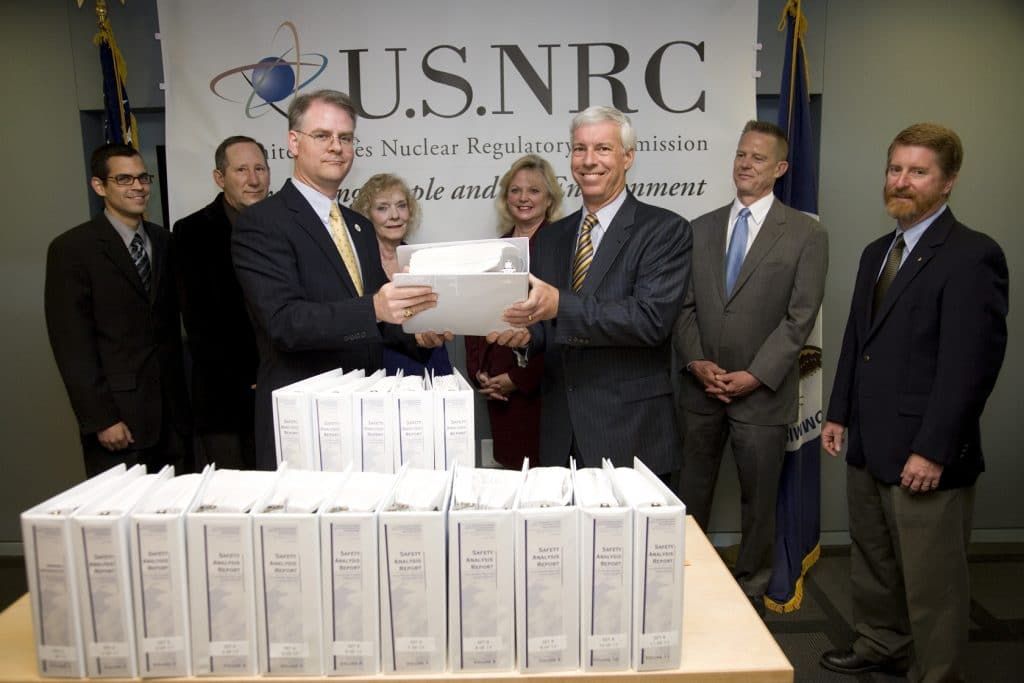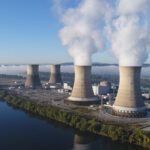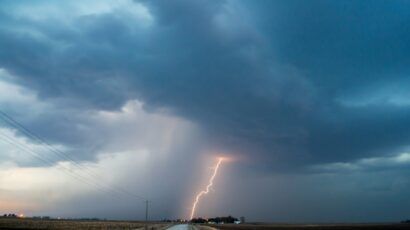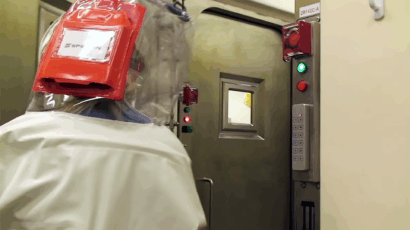If Trump and Biden agree there shouldn’t be a nuclear waste site at Yucca Mountain, can’t we all?
By David Klaus | August 26, 2020
 Energy Department representatives presented the Yucca Mountain license application to the NRC on June 3, 2008. Credit: NRC
Energy Department representatives presented the Yucca Mountain license application to the NRC on June 3, 2008. Credit: NRC
Believe it or not, there is an issue on which Donald Trump and Joe Biden agree: Both have announced their opposition to building an underground repository to permanently store nuclear waste at Yucca Mountain in Nevada. With the presidential candidates on record, it is time for everyone else to accept that Yucca Mountain is finally off the table, and for the United States to begin to seriously consider realistic alternatives for safely managing the more than 80,000 tons of spent nuclear fuel currently sitting at 72 operating and shut-down commercial nuclear reactor sites across the country.
US policy regarding spent fuel disposal has been hung up for decades on whether to build a repository at Yucca Mountain. The site has been controversial since 1987, when Congress designated it as the future home for high-level radioactive waste – provided, of course, that it meets all technical requirements and is licensed by the Nuclear Regulatory Commission. Thirty-plus years and more than $15 billion later, all technical work to assess the site’s suitability has stopped and the licensing review is dead in the water. The US Congress has refused to appropriate funds to the project for years. And because the government has not met its commitment to begin accepting waste for disposal in 1998, it is forced to pay utilities more than $600 million every year to store their spent fuel on site. Moreover, the most realistic approach for managing the tons of spent fuel—an interim storage facility—is held hostage to progress on Yucca Mountain. Current law requires that the NRC issue a license for Yucca Mountain before a consolidated interim storage could begin to accept spent fuel.
The sooner everyone agrees to pull the plug on Yucca Mountain, the sooner the United States can move forward on consolidated storage for the next 40 to 50 years, since this is likely the amount of time it will take to bring a long-term repository into operation. This will give the government time to find a new site using a consent-based process.
The few remaining Yucca Mountain advocates will undoubtedly be reluctant to abandon the project. But in the short term, there is no reason to believe that either Trump or Biden will reverse their announced position following the November election. Although the Trump administration supported Yucca Mountain for three years, the president tweeted an end to that support in February. Biden was a longtime opponent of the project during his years as a senator and vice president, and he reconfirmed his opposition to the project during the lead-up to the Nevada primary.
Nor is there any reason to believe that Congress—which has refused to fund Yucca Mountain for the past decade—will suddenly make a U-turn and start appropriating the billions of dollars required to license, build, and begin operating the project. And even if advocates are able to get funding in one appropriations bill, massive amounts of funding will be required every year for at least the next 20 years—as much as $2 billion per year. Not even the New York Yankees in their prime were able to put together a winning streak that long.
But appropriating funds is only the tip of the iceberg. The State of Nevada, environmental and anti-nuclear organizations, property owners, and other opponents of Yucca Mountain would have a multitude of opportunities to intervene in regulatory proceedings and litigate issues related to the project. According to testimony by Robert J. Halstead, Executive Director of the Nevada Agency for Nuclear Projects, Nevada has been preparing to adjudicate 218 admitted contentions and to submit 30 to 50 new contentions regarding the NRC construction and operating permits. The Commission also must certify transportation casks, emergency plans, evacuation routes, safety procedures, and operator training programs.
Beyond the NRC, other required regulatory reviews and approvals include permits and the acquisition of rights-of-way for the construction of an approximately 300-mile long railroad, US EPA certification of compliance with environmental laws and radiation-protection standards, state water permits, and a host of other state and local approvals associated with any infrastructure project on the scale of Yucca Mountain. None of this will happen smoothly in the face of concerted opposition that is prepared to litigate every step of the way. In addition, federal law empowers the Governor of Nevada to negotiate with the federal government on issues related to a proposed repository, which opens the door for what could be almost endless rounds of negotiations on compensation and benefits to be provided to the state and local communities.
Many of these issues likely would arise even if Yucca Mountain had the ideal geological characteristics and location for a national repository – which it does not. Opponents point to a myriad of technical and logistic issues with the site, starting with fundamental geological problems associated with placing nuclear spent fuel canisters into a fractured rock formation located over a critical aquifer that is used for many purposes. On top of that, they have identified problems with the repository engineering design and transporting spent fuel across the country to Yucca Mountain, particularly given that the site is not located near a main railroad line. Imagine the parade of scientific and technical experts who will be called to testify at the various proceedings, each of whom will have boxes of studies, reports, and assessments to back up their position. And in each instance the burden of proof will be on the government to demonstrate that all aspects of the new repository will be environmentally sound, secure, and safe for thousands of years.
Simply put, the United States’ long-term repository for spent nuclear fuel is not going to be built at Yucca Mountain. With both presidential candidates on record in opposition to the facility, there is reason to hope that the process of developing a national policy to manage the thousands of tons of spent fuel in this country can go forward following the election and will no longer be blocked by advocates for a project that has been on life support for years. The rest of the world is turning to consent-based processes to identify sites for nuclear repositories. Presidential leadership is likely to be required, but it is time for the United States to follow suit and reset its approach to one that is realistic, politically viable, and scientifically sound.
Editor’s note: This is the first in a series of commentaries on America’s nuclear waste.
Together, we make the world safer.
The Bulletin elevates expert voices above the noise. But as an independent nonprofit organization, our operations depend on the support of readers like you. Help us continue to deliver quality journalism that holds leaders accountable. Your support of our work at any level is important. In return, we promise our coverage will be understandable, influential, vigilant, solution-oriented, and fair-minded. Together we can make a difference.
Keywords: Yucca Mountain, spent nuclear fuel
Topics: Nuclear Energy, Opinion
















A few nights ago I had a dream…that a small nuclear fusion process which is clean, leaving no radioactive waste, was possible, developed and working.
Then I woke up.
All this is fine and good, and sounds like such a good idea. Except that all it really says is form committees to fantasize about what to do with 80,000 tons of nuclear waste. And now we’ll have a “consent process”, which leaves out that this is the United States of America, where consensus is impossible. The hard reality is that Yucca Mtn was, and is the best solution within the geologic and engineering constraints. The problem is that we are incapable of implementing it, or any other solution. And waving the magic wand of “consensus” over it is just… Read more »
It’s not up to the Executive branch to decide. Congress needs to change the selection via legislation. Right now, YM is the law.
The only reason YM is off the table is because presidents from both republican and democratic administrations fleeced the NWF of tens of billions of dollars via “offsets” to their budgets, and neither party’s presidents wants to have to step up and “repay” the offsets incurred by the other party’s president. If it was about science, the hearings would have been held. If it was about policy, we would have had alternatives. Where we stand right now is that the bank account has been cleaned out, the licensing proceeding was defunded in mid-stream, and no practical alternatives have been presented.… Read more »
Step one: stop producing more nuclear waste. From either nuclear weapons making or nuclear power production.
I’m a retired geologist and my take on this is that Yucca Mountain is a very good candidate site for nuclear waste disposal. However, the repository perhaps should remain open and allowed to cool with air circulation for about a hundred years. When the waste is not so hot the repository can be sealed. Geologically, all sites have problems, none are 100% safe, and 99.99% safe will not work for as long as nuclear materials inspire visions of mutants and zombies. Dry casks at nuclear power plants actually work quite well for spent fuel. Leave it where it is seems… Read more »
I know it sounds unbelievable, but there is a simple solution to the waste problem. At Nevada Test Site, a stone’s throw from the Yucca Mountain Project, are drill-backs that provide access to previous underground tests. The ground is contaminated with the same decay products and only contained by fused material from the fireball. The simple solution is to seal one of the drill-backs and then dump the waste inside. While working on radiation monitoring at Yucca Mountain, I asked one of the scientists why we don’t do this. The answer was, “We can’t tell if a storage cask is… Read more »
Nevadans have never had the opportunity to vote on Yucca Mountain, either statewide or just in Las Vegas/Clark County whose politicians sworn to pay fealty to Senator Harry Reid’s obsession with stopping the project refuse to consider what the economic stimulus of such a massive public work could do for their constituents. Once flush in the pre-pandemic boom, many now face the prospect of hunger and eviction as hospitality and entertainment industries have cratered. Construction, by contrast, was deemed essential and allowed to continue because its outdoor worksites are the easiest to maintain physical spacing and ventilation is not usually… Read more »
Another thing President Obama, President Trump and Former Deputy Under Secretary Klaus have in common is that none of them have ever received an official briefing on the technical aspects of the License Application for Yucca Mountain. Nor have they received an official briefing on the results of the of more than $10 Billion of scientific studies/investigations into the physical characteristics of the site. Making decisions based on politics Without all of the facts seems to be the commonality here. Consent based siting offers promise, but conveniently omitted is the fact that the State of Nevada asked the Federal Government… Read more »